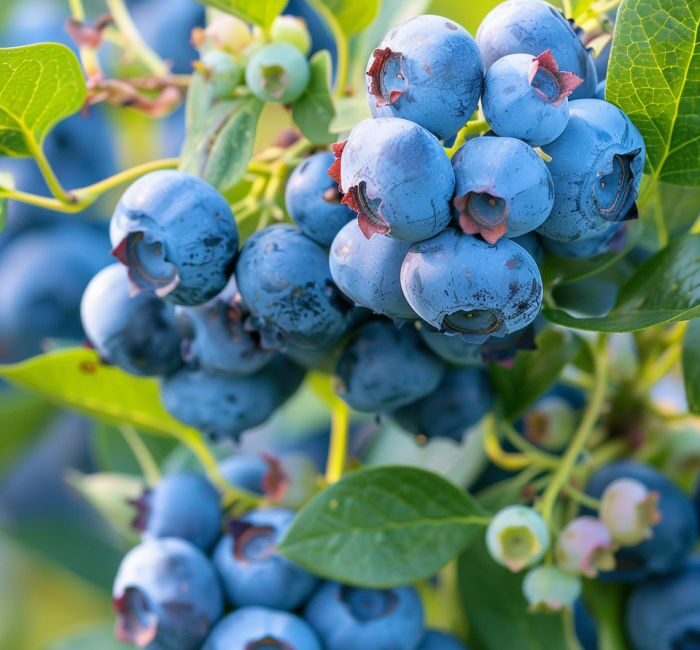Blueberries are not only delicious but also packed with health benefits. Rich in antioxidants, vitamins, and minerals, they have become a popular choice for many gardeners who wish to add a touch of sweetness and nutrition to their gardens. Whether you want to grow blueberries for fresh eating, baking, or preserving, having your own blueberry bush can be an incredibly rewarding experience.
However, growing a bountiful blueberry bush isn’t as simple as planting the bush and walking away. Like any plant, blueberries require proper care, attention, and the right growing conditions to thrive. Fortunately, with the right knowledge and techniques, you can ensure that your blueberry bush grows abundantly and produces fruit year after year.
In this article, we will explore 10 key tactics to help you grow a flourishing blueberry bush in your own backyard.
1. Choose the Right Variety of Blueberry
Before you begin planting your blueberry bush, it’s essential to choose the right variety. Blueberries come in three main types: highbush, lowbush, and rabbiteye. Each type has specific characteristics and growing needs, so it’s important to select one that suits your climate and growing conditions.
- Highbush blueberries are the most common type and thrive in cooler climates. They are typically the tallest variety and produce large, sweet berries.
- Lowbush blueberries are smaller and grow closer to the ground. They tend to be hardier and are often used in colder climates.
- Rabbiteye blueberries are ideal for warmer climates, especially in the southern U.S. They are more drought-resistant but require longer growing seasons.
Ensure you select a variety that suits your local climate and gardening conditions. Additionally, consider planting at least two different varieties for better pollination and higher yields.
2. Plant in the Right Location
Blueberries thrive in specific conditions, and one of the most crucial factors to consider is the location. The ideal spot for a blueberry bush is one that gets plenty of sunlight. Blueberries need at least 6-8 hours of direct sunlight per day to produce an abundant harvest.
However, while they love sunlight, they also require good drainage. Blueberries grow best in acidic, well-drained soil. Ensure that your garden’s soil is slightly acidic, with a pH level between 4.5 and 5.5. If your soil is not naturally acidic, you can amend it by adding sulfur or peat moss to lower the pH.
When selecting the planting site, avoid areas that are prone to heavy winds or where water tends to pool. Consider raised beds or containers if your soil drainage is poor.
3. Proper Soil Preparation
Soil preparation is essential for ensuring that your blueberry bush has the proper nutrients and environment to thrive. To ensure healthy roots and maximum fruit production, start by testing the soil’s pH and adjusting it to the acidic range (4.5 to 5.5).
Here’s how you can prepare the soil for planting your blueberry bush:
- Amend the soil: Incorporate organic matter, such as peat moss or compost, to improve soil texture and drainage.
- Add sulfur: If your soil is too alkaline, add sulfur to help acidify it. The recommended amount will depend on your soil’s current pH level, so be sure to follow guidelines on the sulfur packaging.
- Ensure good drainage: Blueberries do not like soggy roots. Make sure the area has well-drained soil to prevent root rot. If you’re planting in containers, ensure the pots have sufficient drainage holes.
4. Mulch for Moisture and Weed Control
Mulching is a simple yet effective way to promote healthy blueberry growth. Mulch helps retain moisture, suppresses weeds, and maintains a consistent soil temperature, which is especially important during hot summers and cold winters.
Apply a 2-3 inch layer of mulch around the base of the blueberry bush, being careful not to pile it directly against the trunk. Organic mulches such as wood chips, pine needles, or bark work best because they also help acidify the soil as they break down.
Regularly check the mulch and replenish it as needed to maintain its thickness. Mulch can also prevent the roots from overheating during the summer, which can stress the plant.
5. Watering the Right Way
Blueberries have shallow root systems and require consistent moisture to thrive. However, overwatering can be detrimental, leading to root rot. It’s essential to keep the soil moist but not soggy.
Here are some tips for watering your blueberry bush effectively:
- Water deeply: Blueberries need deep watering, especially during dry periods. Water the base of the plant thoroughly, ensuring that the roots absorb the moisture.
- Use drip irrigation: If possible, install a drip irrigation system to provide consistent moisture directly to the roots without wetting the leaves, which can encourage disease.
- Avoid overhead watering: Watering overhead can lead to fungal diseases, especially if the leaves stay wet for extended periods.
Aim to keep the soil consistently moist during the growing season, but be mindful not to saturate the soil.
6. Fertilize with Care
Blueberry bushes require the right balance of nutrients to thrive, but it’s essential to be cautious with fertilization. Over-fertilizing, particularly with high-nitrogen fertilizers, can lead to excessive foliage growth and poor fruit production.
For optimal growth, apply a balanced fertilizer formulated for acid-loving plants. Use it in the early spring, just as the plant begins to show new growth. Avoid fertilizing in late summer or fall, as this can encourage late-season growth that is vulnerable to frost damage.
Organic options, such as fish emulsion or compost, can also be used to feed your plants naturally. Just be sure to follow the recommended application rates and avoid over-fertilizing.
7. Pruning and Shaping the Bush
Pruning your blueberry bush is essential for maintaining its shape, health, and productivity. Pruning encourages better airflow, reduces the risk of disease, and helps the plant focus its energy on producing fruit rather than excessive foliage.
Here’s how to properly prune your blueberry bush:
- Prune in late winter or early spring: Before new growth begins, remove any dead or damaged branches. Focus on removing weak or spindly stems to encourage stronger growth.
- Shape the bush: Trim the bush to maintain a rounded shape. Cut back old wood to allow new shoots to grow, as newer wood typically produces the best fruit.
- Thin out the center: Lightly thinning the center of the bush allows better airflow, which reduces the likelihood of fungal diseases and promotes better fruiting.
By pruning your blueberry bush regularly, you’ll encourage strong growth and increase your yield year after year.
8. Pollination: Help Your Blueberries Thrive
While some blueberry varieties are self-pollinating, you’ll get a better harvest if you plant at least two different varieties. Planting multiple varieties enhances cross-pollination, which leads to larger, sweeter berries.
To encourage pollinators to visit your blueberry bush, consider the following:
- Plant flowering plants nearby: Bees and other pollinators are attracted to flowering plants. By planting companion flowers near your blueberries, you can attract more pollinators to your garden.
- Avoid pesticides: Pesticides can harm beneficial pollinators. If you need to treat your blueberries for pests, use organic solutions that are safe for bees and other pollinators.
9. Protect from Pests and Diseases
While blueberry bushes are relatively resistant to pests and diseases, they are still susceptible to certain issues like aphids, spider mites, and fungal infections. Here’s how you can protect your blueberry bush:
- Inspect regularly: Check your plants regularly for signs of pests, such as discolored or damaged leaves.
- Use natural pest control methods: Introduce beneficial insects like ladybugs to your garden to control aphids. You can also use neem oil or insecticidal soap to treat pest infestations.
- Remove diseased parts: If you notice any signs of disease, such as powdery mildew or rust, remove the affected leaves and dispose of them properly.
By being vigilant and using natural methods to control pests and diseases, you can protect your blueberry bush and keep it healthy for years.
10. Harvesting Blueberries
Blueberries typically begin to ripen in the summer, usually around June to July depending on the variety. To get the best flavor, harvest the berries when they are fully ripe — they should be a deep blue color with a slight powdery bloom.
Here are some tips for harvesting:
- Pick gently: Blueberries are delicate, so pick them gently by hand, being careful not to crush the fruit.
- Harvest regularly: Blueberries ripen gradually, so check your bushes every few days to harvest ripe berries.
With regular harvesting, you’ll be able to enjoy a continuous supply of fresh, home-grown blueberries throughout the season.
Conclusion: Enjoying a Bountiful Blueberry Harvest
Growing a bountiful blueberry bush requires time, effort, and care, but the rewards are well worth it. By implementing these 10 key tactics, you can ensure your blueberry plants thrive and produce an abundance of delicious, nutrient-packed berries each season.
From selecting the right variety and planting in the right location to providing consistent care with watering, fertilizing, and pruning, these steps will set you on the path to a successful blueberry harvest. And with your very own homegrown blueberries, you
can enjoy the freshest fruit without the need to purchase them from the store.
Happy gardening, and here’s to a fruitful blueberry season! 🌱🫐




